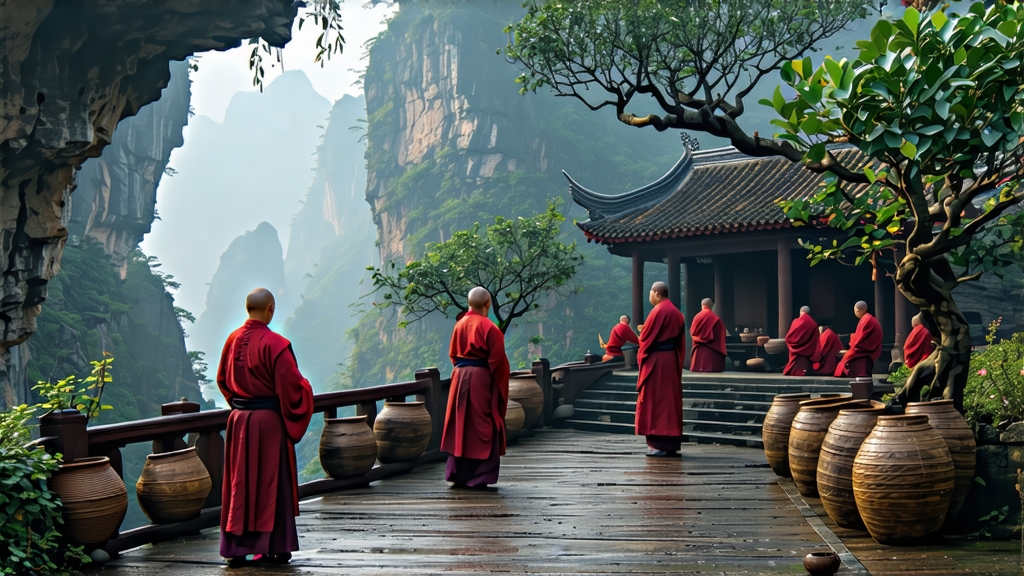
If green tea is the fresh-faced scholar and black tea the stately ambassador, then Wuyi Da Hong Pao stands as the battle-scarred poet who has seen dynasties rise and fall yet still recites verses in a voice of smoked honey and wet stone. Among the five major oolong families of China—Min Bei, Min Nan, Guangdong, Taiwan, and the emerging high-mountain styles—none carries more mythic weight than the “Big Red Robe” that clings to the vertical crevices of Mount Wuyi in northern Fujian. To understand Da Hong Pao is to step into a landscape where Taoist monasteries, imperial couriers, Song-dynasty scholars, and modern auction houses all share the same cliff-side path.
Historical whispers
The name first appears in Ming-era county annals (15th c.) but the legend is older. A Ming emperor’s mother, gravely ill, was revived by a brew sent from Wuyi’s Tianxin Temple; the sovereign draped his own crimson imperial robe over the six mother bushes in gratitude. Whether apocryphal or not, the story fixed the tea’s status as tribute, and Qing administrators sealed the 360-meter “Nine-Dragon Nest” canyon to protect the originals. By 1920 the bushes were already so revered that local magistrates posted stone guards to prevent theft of even a single twig. Today the six Song-dynasty shrubs still live on a 30-metre vertical fissure, their genetic line prolonged through asexual cuttings that preserve the original qi.
Terroir: when rock becomes flavour
Mount Wuyi is a 550-million-year-old rift valley whose purple-red igneous rock weathers into gravelly, mineral-rich soil. Day-night temperature swings of 15 °C force the leaves to thicken their cell walls, concentrating aromatic oils. Constant cloud-fog refracts sunlight into a soft, bluish spectrum that boosts amino acids, while nine mountain streams ionize the air. The locals distill this geology into one word: yan—literally “rock”—which manifests in the cup as a tactile, almost saline grip on the tongue that lingers longer than sweetness. No other oolong can replicate yan yun (“rock rhyme”) because no other place has this lithic heartbeat.
Garden hierarchy
- Mother Trees (母树): the six ancient shrubs, harvested only once (2006) before being retired by government decree; leaves now rest in the China National Tea Museum.
- Qi Dan (奇丹): direct first-generation cuttings from the mothers, yielding fewer than 300 kg a year.
- Bei Dou (北斗): “North Star,” a 1950s regrafting program using scions secretly taken in 1930; more vigorous but still scarce.
- Commercial Da Hong Pao: skillful blends of three Wuyi cultivars—Tie Luo Han, Bai Ji Guan, Shui Jin Gui—designed to echo the original profile while remaining affordable. A 2022 auction saw 20 g of Qi Dan fetch USD 42,000, yet a well-crafted blend can deliver 70 % of the sensory drama for the price of a specialty coffee.
Craft: the slow violence of charcoal
Picking occurs in late April when the third leaf is half the size of the little finger. After solar withering, the leaves are shaken in 2-metre-long bamboo drums every hour through the night to bruise the edges, initiating oxidation at 25 °C. At 50 % oxidation—midway between green and black—the leaves are flash-fried at 220 °C to kill the enzymes, then rolled into the tight, black-green stripes that resemble miniature dragon tails. The critical act is the charcoal roast: firing over local hardwood ash at 85–95 °C for 8–12 hours, repeated up to three times over 90 days. The tea master sleeps in 90-minute cycles, nose pressed to the bamboo tray, adjusting distance every few minutes; one lapse and the batch tastes of burnt toast rather than smouldering incense. Between firings the tea “rests” in earthen jars so that moisture migrates from core to surface, allowing a deeper, more even bake. The result is a leaf that gleams like obsidian and smells of pipe tobacco, dried longan, and the moment hot granite meets rain.
Water, fire, and patience: gongfu infusion
Da Hong